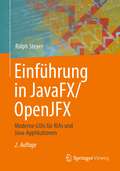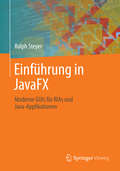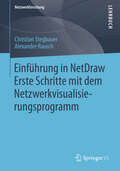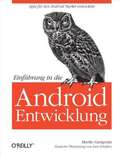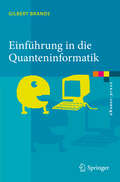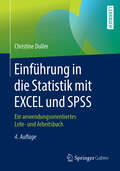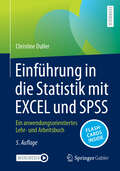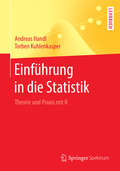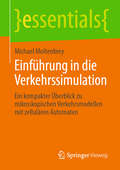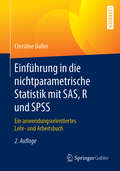- Table View
- List View
Einführung in JavaFX/OpenJFX: Moderne GUIs für RIAs und Java-Applikationen
by Ralph SteyerDas JavaFX-Framework gibt es schon seit einigen Jahren, hat aber mit den ersten Versionen fast nur noch den Namen gemeinsam. Seit der Version 2 hat JavaFX jedoch einen festen und ausgereiften Stand erreicht und ist mittlerweile die aktuelle Technologie im Java-Umfeld, um leistungsfähige und moderne grafische Benutzeroberflächen (GUI) erstellen zu können. Dieses Buch stellt Ihnen dazu eine Vielzahl an Widgets und Komponenten samt dem JavaFX-API vor. Es zeigt Ihnen auch, wie Sie mit Hilfe des APIs sowohl aus Java heraus, aber auch über einen XML-basierenden Ansatz (FXML) samt einem visuellen Designer-Tool (Scene Builder) grafische User-Interfaces erstellen können. So können Sie sogar ohne Java-Kenntnisse eine leistungsfähige und moderne GUI erstellen, aber auch Kenntnisse in anderen GUI-Technologien wie Swing übertragen und sogar diese Komponenten in JavaFX integrieren.
Einführung in JavaFX: Moderne GUIs für RIAs und Java-Applikationen
by Ralph SteyerDas JavaFX-Framework gibt es schon seit einigen Jahren, hat aber mit den ersten Versionen fast nur noch den Namen gemeinsam. Mit der Version 2 hat JavaFX einen festen und ausgereiften Stand erreicht und wird als die kommende Technologie im Java-Umfeld angesehen, um leistungsfähige und moderne grafische Benutzeroberflächen (GUI) erstellen zu können. Dieses Buch stellt Ihnen dazu eine Vielzahl an neuen Widgets und Komponenten samt einem neuen Java-API vor, das Swing ablösen soll. Es zeigt Ihnen auch, wie Sie mit Hilfe des neuen APIs sowohl aus Java heraus, aber auch über einen neuen XML-basierenden Ansatz (FXML) samt einem visuellen Designer-Tool (Scene Builder) grafische User-Interfaces erstellen können. So können Sie sogar ohne Java-Kenntnisse eine leistungsfähige und moderne GUI erstellen.
Einführung in NetDraw: Erste Schritte mit dem Netzwerkvisualisierungsprogramm (Netzwerkforschung)
by Christian Stegbauer Alexander RauschDer Band führt anschaulich in das Programm „NetDraw“ Schritt für Schritt ein und ermöglicht den LeserInnen die Nutzung des Programms innerhalb weniger Stunden.
Einführung in Optimierungsmodelle: Mit Beispielen und Real-World-Anwendungen in Python
by Nathan Sudermann-MerxDieses Buch könnte interessant für Sie sein, falls Sie über eine solide mathematische Ausbildung verfügen und nun Anwendungsprobleme mit Hilfe von Optimierungsmodellen lösen möchten, ohne sich zuvor jahrelang mit der zugehörigen Theorie zu beschäftigen.Ein lineares gemischt-ganzzahliges Optimierungsproblem kann heute etwa 500 Milliarden Mal schneller gelöst werden als zu Beginn der 90er Jahre und lässt sich in leicht zu erlernenden Programmiersprachen wie Python formulieren. Da Sie Optimierungsalgorithmen für Real-World-Anwendungen in der Regel nicht selbst schreiben werden, lassen wir diesen Aspekt außen vor und wenden uns stattdessen der wunderschönen Welt der Modellierung zu. Sie lernen, echte Anwendungen in der Sprache der Mathematik zu beschreiben und implementieren alle vorgestellten Modelle in Python, um sie anschließend von bereits existierenden Solvern lösen lassen. Dieses anwendungsnahe Vorgehen soll Sie befähigen, selbst Optimierungsprobleme in der Praxis zu lösen.
Einführung in das Informationsmanagement (Springer-Lehrbuch)
by Helmut KrcmarInformationsgesellschaft, Information als Wettbewerbsfaktor, Informationsflut: Diese Stichworte verdeutlichen die unternehmerische und gesellschaftliche Bedeutung von Informationen. Doch nicht nur Information allein, sondern auch die Systeme, die Informationen verarbeiten, speichern und übertragen sowie die Technologien, auf denen sie beruhen, verdienen Aufmerksamkeit. Informationsmanagement hat die Aufgabe, den im Hinblick auf das Unternehmensziel bestmöglichen Einsatz der Ressource Information zu gewährleisten. Es zählt zu den wesentlichen Bestandteilen heutiger Unternehmensführung. Das Lehrbuch vermittelt in 13 Einheiten die Grundlagen des Informationsmanagements. Dabei werden neben den Managementaufgaben der Informationswirtschaft, der Systeme und der Technologien auch ausgewählte Führungsaufgaben des Informationsmanagementsbehandelt. Jede Lehreinheit beginnt mit einem Überblick über die behandelten Themen und schließt mit einer Zusammenfassung sowie Aufgaben zur Wiederholung ab. So richtet sich dieses Buch insbesondere an Bachelorstudenten in den Fächern Wirtschaftsinformatik, BWL und Informatik.
Einführung in das Metaverse: Technologien, Anwendungen und Zukunft
by Fabian LangDieses Buch bietet eine fundierte Einführung in die Grundlagen, Prinzipien und Anwendungen des Metaverse. Es beleuchtet die wesentlichen Aspekte erweiterter Realitäten und virtueller Welten und legt besonderen Wert auf die Verknüpfung mit dem dezentralen Web3 und Distributed-Ledger-Technologien. Diese Verbindung schafft neue Möglichkeiten für zukunftsweisende Geschäftsmodelle im Metaverse. Neben den theoretischen Grundlagen präsentiert das Buch praxisnahe Fallstudien, die reale Anwendungsbeispiele aus verschiedenen Branchen beleuchten und wertvolle Einblicke für Strateg:innen und Innovator:innen bieten. Es widmet sich auch den technologischen, rechtlichen und sozialen Herausforderungen und liefert einen interdisziplinären Ausblick auf die Zukunft und Entwicklung des Metaverse – jenseits des Hypes. Mit umfassenden Erklärungen, praxisorientierten Einordnungen und über 100 anschaulichen Abbildungen richtet sich dieses Buch an Innovations- und Digitalmanager:innen, Studierende sowie alle, die verstehen möchten, wie das Metaverse die Wirtschaft und Gesellschaft transformieren könnte.
Einführung in die Bioinformatik in der Mikrobiologie
by Henrik ChristensenDieses Lehrbuch führt in die grundlegenden Konzepte der Bioinformatik ein und verbessert die Fähigkeiten der Studierenden im Umgang mit Software und Werkzeugen, die speziell für die Lösung von mikrobiologischen Fragestellungen relevant sind. Es werden die wichtigsten Methoden zur Analyse von Daten aufgezeigt und die Leser werden darin geschult, auf der Grundlage der erzielten Ergebnisse gültige Schlussfolgerungen zu ziehen. Weiters stellen die Autoren hilfreiche Programme und Server vor, die kostenlos im Internet genutzt werden können, präsentieren aber zusätzlich fortgeschrittenere eigenständige Software als zweite Option.. Zur Vertiefung des Erlernten werden am Ende jedes Kapitels unterhaltsame Übungen und Quizfragen angeboten. Das Buch richtet sich an Doktoranden und fortgeschrittene Studierende der Mikrobiologie, Biotechnologie und (Veterinär-)Medizin mit geringen bis grundlegenden Kenntnissen in Bioinformatik.
Einführung in die Computeranimation: Methoden, Algorithmen, Grundlagen
by Stefan M. GrünvogelDas Buch ist das erste umfassende deutschsprachige Lehrbuch zur Computeranimation, das sich speziell an Studierende der Informatik und der Ingenieurwissenschaften richtet, die ihr Verständnis der mathematischen Grundlagen und Algorithmen dieses spannenden Gebiets vertiefen wollen. Das Lehrbuch ist in vier Hauptteile gegliedert und deckt damit alle wichtigen Bereiche der Computeranimation ab: Animationssysteme, Objektanimation, Charakteranimation und Prozedurale Animation. Jeder Teil ist in weitere Kapitel unterteilt und bietet eine detaillierte Darstellung der Algorithmen und Methoden der Computeranimation mit ausführlichen Erklärungen.Im ersten Teil werden die wichtigsten Konzepte von Animationssystemen wie Szenengraphen, Zeit und Game Loop erläutert. Im zweiten Teil geht es um die Animation und Steuerung von Objekten entlang von Kurven, die die Grundlage vieler Animationstechniken bilden. Im dritten Teil wird das Gebiet der Charakteranimation ausführlich behandelt. Kinematik und inverse Kinematik werden diskutiert, Skinning-Methoden vorgestellt und Motion-Capture und die Verarbeitung von Bewegungsdaten ausführlich beschrieben. Der letzte Teil des Buches beschäftigt sich mit der prozeduralen Animation und stellt verschiedene Algorithmen für physikalisch basierte Animation und Partikelsysteme vor. Im gesamten Buch finden sich zahlreiche Beispiele und Illustrationen, die das Verständnis der behandelten Konzepte und Verfahren vertiefen. Am Ende jedes Kapitels finden sich Verweise auf historische und weiterführende Literatur, die zu weiterer Forschung anregen. Ein wichtiger Teil des Buches sind die zahlreichen Übungen und Projekte, die helfen, das Gelernte zu vertiefen und selbst zu erproben.
Einführung in die Entwurfsautomatisierung für Quantencomputer
by Robert Wille Alwin ZulehnerDieses Buch bietet dem Leser einen einfachen Einstieg in das Quantencomputing sowie in den Entwurf entsprechender Geräte. Die Autoren behandeln verschiedene Entwurfsaufgaben, die für das Quantencomputing wichtig sind, und stellen entsprechende Lösungen vor. Eine Besonderheit des Buches ist, dass diese Aufgaben und Lösungen explizit aus der Perspektive der Entwurfsautomatisierung diskutiert werden, d.h. unter Verwendung von cleveren Algorithmen und Datenstrukturen, die von der Entwurfsautomatisierungs-Community für konventionelle Logik (d.h. für elektronische Geräte und Systeme) entwickelt worden sind und nun für diese neue Technologie angewendet werden. Auf diese Weise können relevante Entwurfsaufgaben wesentlich effizienter als bisher durchgeführt werden, was zu Verbesserungen um mehrere Größenordnungen führt (in Bezug auf die Laufzeit und andere Entwurfsziele). Beschreibt den aktuellen Stand der Technik für den Entwurf von Quantenschaltungen, für deren Simulation und für deren Abbildung auf reale Hardware; Bietet eine erste umfassende Einführung in die Entwurfsautomatisierung für Quantencomputer, die sich mit praxisrelevanten Aufgabenstellungen befasst; Es richtet sich sowohl an die Quantencomputer-Gemeinschaft als auch an die Gemeinschaft der Entwurfsautomatisierung und zeigt, welche beeindruckenden Verbesserungen möglich sind, wenn man das Wissen beider Gemeinschaften kombiniert.
Einführung in die Informatik: Theoretische und praktische Grundlagen (Studienbücher Informatik)
by Bastian KüppersDieses Buch bietet eine praxisnahe Einführung in grundlegende Themen der Informatik wie Codierung, Rechnerarchitekturen und Betriebssysteme. Der Fokus liegt dabei auf Verständlichkeit und einem roten Faden. Im Laufe des Buches wird über das Konzept der Information und deren Codierung bzw. Verarbeitung die Arbeitsweise des Computers motiviert und darauf aufbauend Hardware, Software und deren Zusammenspiel diskutiert. Dabei wird ebenso auf klassische Computer wie auch auf Quantencomputer eingegangen. Zudem werden die Themen Datenschutz und Datensicherheit beleuchtet, welche an der Schnittstelle zwischen Informatik und dem täglichen Leben angesiedelt sind.Zu den einzelnen Themen gibt es Übungsaufgaben mit Lösungen.
Einführung in die Mediaplanung: Grundlagen für klassische und digitale Kanäle (essentials)
by Runa StrottDieses Buch gibt einen kompakten Einblick in die Basics der klassischen und digitalen Mediaplanung. Heutzutage werden Werbebudgets mehr denn je immer wieder neu justiert, und die Mediaplanung wird komplexer. Die Herausforderungen an eine adäquate Zielgruppenansprache sind enorm, denn das Zusammenspiel der einzelnen Kanäle oder auch die gezielte Auswahl individueller Botschaften fordern ein detailliertes Verständnis darüber, wann welche Instrumente die Zielgruppen erreichen und zum gewünschten Ergebnis führen können. Von der Medienauswahl über die Zielgruppenanalyse bis hin zum Controlling werden in diesem Essential sowohl für klassische und lang etablierte Kanäle als auch für neue, digitale Kanäle die ersten Schritte der Mediaplanung erläutert.Ein Buch für Mediaplanungseinsteiger, Studierende und Schaffende der Medienwelt, die sich die Grundlagen aneignen wollen.
Einführung in die Optimierung: Konzepte, Methoden und Anwendungen
by Christian Grimme Jakob BossekDieses Lehrbuch vermittelt einen breiten und grundlegenden Einblick in die Methoden der mathematischen Optimierung. Im Fokus stehen Algorithmen, verschiedene Optimierungsprobleme und ihre Komplexität sowie nützliche Lösungsmethoden. Dabei haben die Autoren, Informatiker und Optimierungsexperten der Westfälischen Wilhelms-Universität Münster, die Konzepte ausführlich und leicht verständlich dargestellt und außerdem viel Wert auf die Anwendung der Problemstellungen und Lösungsverfahren auf Beispielfälle gelegt. Denn ob Bauteile passend gemacht, Personaleinsatz effizient geplant oder Transportnetzwerke effektiv gestaltet werden sollen – immer geht es um die Verbesserung von Systemen und die strukturierte Durchführung dieser Optimierung. Das Fachgebiet der mathematischen Optimierung wird daher auch häufig als Operations Research oder Unternehmensforschung bezeichnet.Das Buch beginnt mit einer Einführung in die Grundbegriffe der Optimierung und die Graphentheorie und erläutert zunächst lineare Problemformulierungen sowie den Simplex-Algorithmus als zentrales Lösungsverfahren. Anschließend werden nichtlineare Problemstellungen und zumeist heuristische Verfahren beschrieben. Hier liegt der Schwerpunkt auf Evolutionären Algorithmen, einer Klasse von randomisierten Optimierungsverfahren, die bei der Lösung komplizierter ingenieurtechnischer Probleme immer mehr an Bedeutung gewinnen.Am Schluss des Buchs betrachten die Autoren das Thema aus der Perspektive der Entscheidungs- und Spieltheorie. Denn die Optimierung, wie sie in den vorangehenden Kapiteln betrachtet wird, ist genau genommen ein Spezialfall der Entscheidungstheorie. Der Band enthält zahlreiche Übungsaufgaben mit Lösungen, die die Autoren in ihren Vorlesungen erprobt haben. Alle praktischen Problemstellungen werden durch Lösungsimplementierungen in der Programmiersprache Python (ab Version 3) und, wo möglich, mit realen Datensätzen ergänzt. Zahlreiche praktische Beispiele und Anwendungsfälle, auch aus der aktuellen Forschung, stehen als vertiefendes Begleitmaterial online zur Verfügung.
Einführung in die Quanteninformatik
by Gilbert BrandsAusgehend von der Theorie und den Protokollen der Quantenkryptografie werden in dem Band die Servicequalitäten vorgestellt, die angesichts der aktuellen technischen Möglichkeiten erreichbar sind. Unter Berücksichtigung wenig beachteter Gesichtspunkte der Kryptoanalyse diskutiert der Autor die erreichbare Sicherheit und untersucht die Möglichkeiten des Quantencomputing. Anhand praxisnaher Aufgaben können Leser ihr Wissen vertiefen und lernen, die Techniken kritisch zu bewerten. Mit Programmieranleitung für Simulationsversuche auf dem eigenen Rechner.
Einführung in die Softwaretechnik (Xpert.press)
by Manfred Broy Marco KuhrmannDas Buch führt in die Grundlagen der Softwaretechnik ein. Dabei liegt sein Fokus auf der systematischen und modellbasierten Software- und Systementwicklung aber auch auf dem Einsatz agiler Methoden. Die Autoren legen besonderen Wert auf die gleichwertige Behandlung praktischer Aspekte und zugrundeliegender Theorien, was das Buch als Fach- und Lehrbuch gleichermaßen geeignet macht. Die Softwaretechnik wird im Rahmen eines systematischen Frameworks umfassend beschrieben. Ausgewählte und aufeinander abgestimmte Konzepte und Methoden werden durchgängig und integriert dargestellt.Die AutorenProf. Dr. Dr. h.c. Manfred Broy war Inhaber des Lehrstuhls für Software & Systems Engineering an der Technischen Universität München. Seine Schwerpunkte in Forschung und Lehre waren und sind die Entwicklung sicherheitskritischer eingebetteter Systeme, mobile und kontextadaptive Softwaresysteme, und Entwicklungsmethoden für leistungsfähige, industriell einsetzbare Softwaresysteme. In zahlreichen Industriekooperationen konnte die Arbeiten des Lehrstuhls angewendet und evaluiert werden. Für seine Arbeit wurde Manfred Broy vielfach ausgezeichnet. Prof. Dr. Marco Kuhrmann vertritt den Lehrstuhl Software Engineering I an der Universität Passau. Seine Schwerpunkte in Forschung und Lehre sind die Methodik des Software Engineering mit dem Fokus auf agile/hybride Software- und Produktentwicklung sowie das Prozess- und Qualitätsmanagement. Er ist einer der Entwickler des V-Modell® XT, dessen Anpassung und Einführung in Organisationen und Projekten er bereits vielfach begleitet hat.
Einführung in die Statistik mit EXCEL und SPSS: Ein anwendungsorientiertes Lehr- und Arbeitsbuch
by Christine DullerDieses Lehrbuch führt leicht verständlich und anwendungsorientiert in die beschreibende und schließende Statistik sowie in die Wahrscheinlichkeitsrechnung ein:Die Methoden der Statistik werden nicht nur beschrieben, sondern auch in EXCEL und SPSS umgesetzt.Zahlreiche Beispiele mit Lösungen ergänzen die Darstellung, daher ist das Buch auch für das Selbststudium gut geeignet.Wesentliche Aspekte sind übersichtlich zusammengefasst, um das Lernen zu erleichtern und ein schnelles Nachschlagen zu ermöglichen.In der vierten Auflage wurden inhaltliche Ergänzungen (Boxplots und Fisher-Test) vorgenommen und die Software-bezogenen Inhalte an die jeweils aktuellen Versionen angepasst (IBM SPSS Statistics 25, Microsoft EXCEL 2019).
Einführung in die Statistik mit EXCEL und SPSS: Ein anwendungsorientiertes Lehr- und Arbeitsbuch
by Christine DullerDieses Lehrbuch führt leicht verständlich und anwendungsorientiert in die beschreibende und schließende Statistik sowie in die Wahrscheinlichkeitsrechnung ein: Die Methoden der Statistik werden nicht nur beschrieben, sondern auch in EXCEL und SPSS umgesetzt. Zahlreiche Beispiele mit Lösungen ergänzen die Darstellung, daher ist das Buch auch für das Selbststudium gut geeignet. Wesentliche Aspekte sind übersichtlich zusammengefasst, um das Lernen zu erleichtern und ein schnelles Nachschlagen zu ermöglichen. Für die 5. Auflage wurden umfangreiche Ergänzungen vorgenommen, alle Software-bezogenen Inhalte an die jeweils aktuellen Versionen angepasst (IBM SPSS Statistics 29, Microsoft EXCEL 2021) sowie insbesondere mehrere Hundert Flashcards ergänzt. Zusätzliche Fragen per App: Laden Sie die Springer-Nature-Flashcards-App kostenlos herunter und nutzen Sie exklusives Zusatzmaterial, um Ihr Wissen zu prüfen.
Einführung in die Statistik: Theorie und Praxis mit R
by Andreas Handl Torben KuhlenkasperDieses Lehrbuch motiviert und erklärt die Inhalte der deskriptiven und induktiven Statistik, indem es die mathematischen Grundlagen der Statistik mit vielfältigen, leicht nachvollziehbaren Anwendungen und Beispielen verbindet: Durch überschaubare Beispiele, die mit Papier und Stift durchgerechnet werden können (und sollten!) gewinnt der Leser zunächst Verständnis und einen routinierten Umgang mit den zentralen Formeln. Für größere Beispiele kommt das frei verfügbare statistische Software R zum Einsatz, welches die Berechnungen schnell und verlässlich auch für große Datensätze umsetzt.
Einführung in die Verkehrssimulation: Ein kompakter Überblick zu mikroskopischen Verkehrsmodellen mit zellulären Automaten (essentials)
by Michael MoltenbreyMobilität dominiert unser Leben. Der Straßenverkehr ist sowohl Keimzelle als auch Lebensader unserer modernen Gesellschaft. Doch wie kann man diesen fassen, planen und berechnen? Während der öffentliche Nahverkehr zumeist vorgegebenen Strukturen folgt – wie zum Beispiel ein Zug seinen Schienen – wirken die Bewegungen des Individualverkehrs chaotisch für den außenstehenden Beobachter. Dieses essential bringt Ordnung in das Chaos und setzt sich mit der mikroskopischen Verkehrssimulation auseinander. Michael Moltenbrey konzentriert sich auf die Vermittlung eines sehr einfachen und rudimentären Verkehrsmodells, welches die Bewegungen einzelner Fahrzeuge abbildet. Auf den ersten Blick sind die Bewegungen der einzelnen Verkehrsteilnehmer unvorhersehbar. Auf den zweiten erkennt man wiederkehrende Strukturen und Muster, die helfen, das Gesamtkonzept Verkehr besser zu erfassen.
Einführung in die Wirtschaftsinformatik
by Walter Brenner Claudia Lemke Kathrin KirchnerDieses Lehrbuch ist eine moderne und zukunftsweisende Einführung in die Wirtschaftsinformatik. Es kombiniert strategisches Wissen mit operativem Know-How. Als Leitfaden zur aktiven Gestaltung der komplexen Herausforderungen ist es die logische Fortsetzung des erfolgreichen ersten Bandes zum "Verstehen des digitalen Zeitalters".Die digitale Transformation ist die umfassendste Reformationsaufgabe von Wirtschaft und Gesellschaft und erfordert ein neues Set an Führungs- und Managementprinzipien. Daten und Algorithmen sind hierbei der universelle Rohstoff im digitalen Zeitalter. Das Buch liefert eine gut verständliche Einführung in die Programmierung und stellt ein Managementsystem zur Gestaltung der digitalen Transformation vor. Als Lehrbuch enthält es Lernziele und Kontrollfragen sowie Literaturempfehlungen zur weiterführenden Diskussionen. Dieser zweite Band eignet sich nicht nur für Studierende, sondern kann auch von Praktikern genutzt werden.
Einführung in die Wirtschaftsinformatik
by Jan Marco LeimeisterDas Buch gibt eine fundierte und praxisbezogene Einführung in das Gesamtgebiet der Wirtschaftsinformatik. Aufbauend auf den bewährten Vorgängerauflagen von Stahlknecht und Hasenkamp wurde die 13. Auflage komplett überarbeitet, strukturell weiterentwickelt und aktualisiert. Die Schwerpunkte umfassen u.a. Datenmanagement, Big Data, Analytics und Systementwicklung, Digital Business, Digitale Transformation, IT-Management sowie IT-Anwendungssysteme. Zusatznutzen: Laden Sie die Springer Nature Flashcards-App kostenlos herunter und überprüfen Sie Ihr Wissen.
Einführung in die Wirtschaftsinformatik
by Jan Marco LeimeisterDas Buch gibt eine fundierte und praxisbezogene Einführung in das Gebiet der Wirtschaftsinformatik. Aufbauend auf den bewährten Vorgängerauflagen von Stahlknecht und Hasenkamp wurde die 14. Auflage überarbeitet, strukturell weiterentwickelt und aktualisiert. Die Schwerpunkte umfassen u.a. generative KI, rechtliche Neuerungen für KI, Anwendungsentwicklung mit Low-Code/No-Code, Rechnernetze und Computing. Zusatznutzen: Laden Sie die Springer Nature Flashcards-App kostenlos herunter und überprüfen Sie Ihr Wissen.
Einführung in die Wirtschaftsinformatik: Band 1: Grundlagen des digitalen Zeitalters
by Walter Brenner Claudia LemkeDie Informations- und Kommunikationstechnik ist heute ein allgegenwärtiger Teil unseres privaten und geschäftlichen Lebens geworden. Diese tiefgreifende Veränderung von Wirtschaft und Gesellschaft entspricht den Auswirkungen der vergangenen industriellen Revolution. Dieses Lehrbuch bricht bewusst mit den traditionellen Ausbildungskonzepten der Wirtschaftsinformatik und stellt die Menschenzentrierung in den Mittelpunkt der privaten und beruflichen Nutzung von Informations- und Kommunikationstechnik. Aus dem Blickwinkel von Digital Natives werden die Grundlagen des digitalen Zeitalters und die wesentlichen Wirkungsweisen der Informations- und Kommunikationstechnik erklärt und zentrale Herausforderungen thematisiert. Zahlreiche Fallbeispiele erläutern die Definitionen, Konzepte und Methoden. Lernziele, Kontrollfragen und Diskussionsaufgaben runden dieses Lehrbuch ab. Die 2. Auflage wurde aktualisiert und um neue technologische Entwicklungen sowie Aufgaben in der Flashcards-App ergänzt. In dem vorliegenden ersten Band geht es um das Verstehen des digitalen Zeitalters. Im folgenden aktualisierten Band 2 stehen die Grundlagen der Programmierung und Datenanalytik im Vordergrund und im neuen Band 3 das Design und Management des digitalen Zeitalters. Zusatznutzen: Laden Sie die Springer Nature Flashcards-App kostenlos herunter und überprüfen Sie Ihr Wissen.
Einführung in die nichtparametrische Statistik mit SAS, R und SPSS: Ein anwendungsorientiertes Lehr- und Arbeitsbuch
by Christine DullerChristine Duller gibt in diesem Buch eine leicht verständliche Einführung in die nichtparametrische Statistik. Dabei beschreibt sie nicht nur die statistischen Verfahren, sondern setzt diese auch in SAS und R um. Beide Programmiersprachen stellt die Autorin kurz vor, sodass keine Vorkenntnisse notwendig sind. Das Buch eignet sich besonders für Studierende der Wirtschafts- und Sozialwissenschaften und alle Interessierten, die (nur) über Grundkenntnisse der Statistik verfügen, aber auch als Nachschlagewerk für einfache statistische Analysen.
Einführung in die statistische Auswertung von Experimenten: Theorie und Praxis mit R
by Andreas Handl Torben KuhlenkasperDieses Lehrbuch stellt eine Vielzahl von Werkzeugen zur Analyse von Experimenten zur Verfügung: Es zeigt die Grundlagen der Auswertung faktorieller Versuchspläne mittels ein- oder mehrfaktorieller Varianzanalysen (ANOVA) sowie mittels gängiger nichtparametrischer Alternativen. Darüber hinaus werden auch Verfahren zur Überprüfung der Annahmen von Varianzanalysen vorgestellt.Die einzelnen Verfahren werden zunächst anhand übersichtlicher Beispiele und Datensätze motiviert, vorgestellt und mit Papier und Stift durchgerechnet. Für größere Beispiele kommt die frei verfügbare statistische Software R zum Einsatz, mit der die manuellen Berechnungen nachvollzogen und schließlich auch größere Datensätze ausgewertet werden können.
